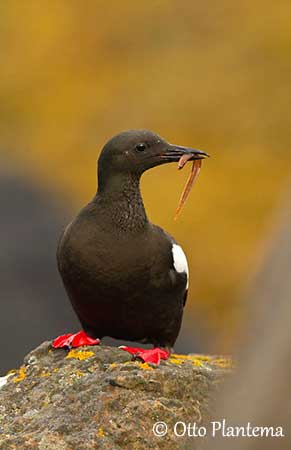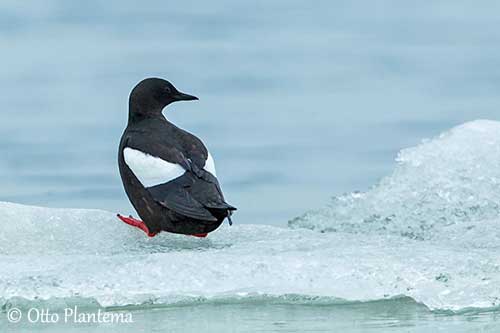
Fr: Guillemot à miroir
Ang: Black Guillemot
All: Gryllteiste
Esp: Arao Aliblanco
Ita: Uria nera
Nd: Zwarte Zeekoet
Sd: Tobisgrissla
Photographers:
John Anderson
John Anderson Photo Galleries
Otto Plantema
Trips around the world
Text by Nicole Bouglouan
Sources:
HANDBOOK OF THE BIRDS OF THE WORLD Vol 3 by Josep del Hoyo-Andrew Elliott-Jordi Sargatal - Lynx Edicions - ISBN : 8487334202
THE HANDBOOK OF BIRD IDENTIFICATION FOR EUROPE AND THE WESTERN PALEARCTIC by Mark Beaman, Steve Madge - C. Helm - ISBN: 0713639601
THE COMPLETE BOOK OF BRITISH BIRDS – Written by “Royal Society for the Protection of Birds” experts - Préface de Magnus Magnusson - Michael Cady- Rob Hume Editors - ISBN: 0749509112
Alaska Seabird Information Series – Black Guillemot
Animal Diversity Web (University of Michigan Museum of Zoology)
All About Birds (Cornell Lab of Ornithology)
Black Guillemot
Cepphus grylle
Charadriiformes Order – Alcidae Family
INTRODUCTION:
The Black Guillemot has circumpolar breeding distribution. It breeds in small, scattered colonies, unlike other auks which form dense colonies. It is usually seen alone or in small groups. It forages by diving underwater and it may remain submerged for up to a minute or more. It feeds usually in shallow inshore waters, and the conspicuous white wing patch and the red legs and feet allow us to follow the bird underwater if watched with binoculars from clifftop.
The Black Guillemot is vulnerable to oil spills near the shores, and threatened by introduced minks and rats that eat eggs and chicks, but currently, the population appears stable and even increasing in North America.

DESCRIPTION OF THE BIRD:
Biometrics:
Length: 30-32 cm
Wingspan: 52-58 cm
Weight: 450-550 g
The Black Guillemot adult in breeding plumage is entirely black to blackish-brown, except for the white patch on the upperwing, and the white underwing-coverts.
Some individuals may occasionally lack the wing patches.
The slender, pointed bill is black with vermilion mouth-lining (usually seen during threat and courtship displays). The eyes are dark brown. Legs and webbed feet are bright red with black claws.
The Black Guillemot is very similar to the Pigeon Guillemot of Pacific coast, and overlaps with it locally in Alaska.
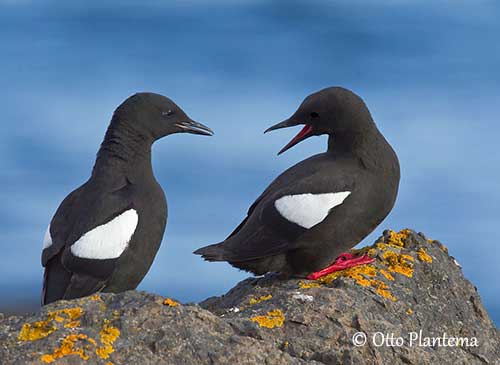
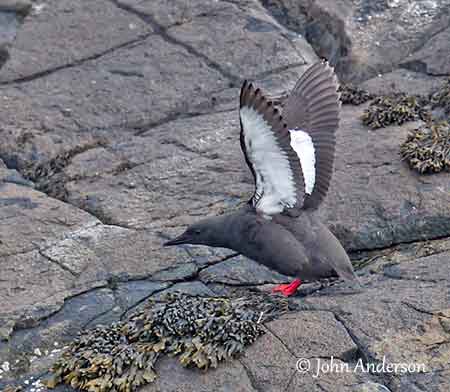
The adult in winter appears pale grey, but it retains the white wing patches. Head and underparts are white, whereas upperparts are speckled greyish-brown, black and white.
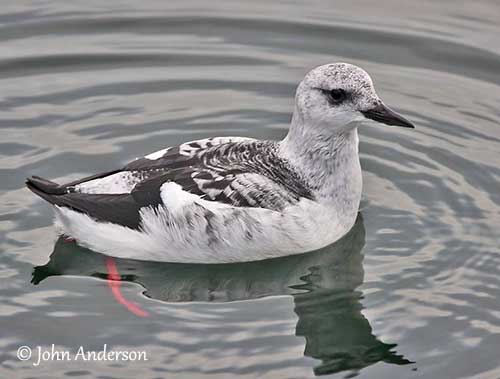
The juvenile resembles adult in winter, but the upperwing patch is mottled and the wing-coverts are tipped brown.
SUBSPECIES AND RANGE:
The Black Guillemot has five recognized subspecies which differ in wing length, bill length and depth, and amount of white on the upperwing.
C.g. mandtii occurs in Arctic, E North America, S to Labrador and N Newfoundland, W and E Greenland, Jan Mayen and Svalbard, E through E Siberia to N Alaska.
C.g. arcticus is found in North America (S of previous race), and S Greenland to British Islands, Norway, SW Sweden, Denmark, Murmansk and White Sea.
C.g. islandicus occurs in Iceland.
C.g. faeroeensis occurs on Faeroes.
C.g. grylle is found in Baltic Sea.
They winter usually near their breeding grounds, except in areas with frozen water. The species is casual S to Long Island and New Jersey, and to N France.
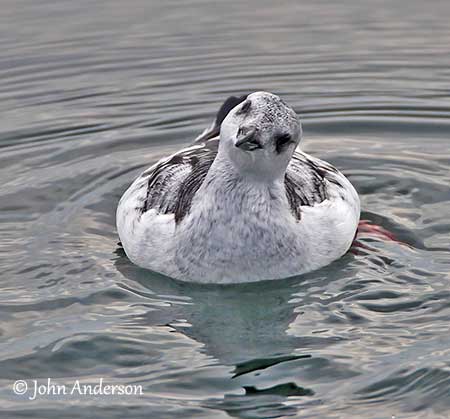
HABITAT:
The Black Guillemot breeds on rocky shores and islands. It nests in crevices among stones and boulders at base of cliffs, or in cracks in cliff face, occasionally under rocks among vegetation or under driftwood.
This species is more pelagic during winter. It can be seen feeding at the edge of the pack ice. Some birds may winter in polynyas in the high north.
CALLS AND SONGS: SOUNDS BY XENO-CANTO
The Black Guillemot gives a variety of weak, high-pitched whistles « peeeeeh » mainly heard around the breeding sites.
In aggressive behaviour, the bird calls while displaying the red mouth-lining.
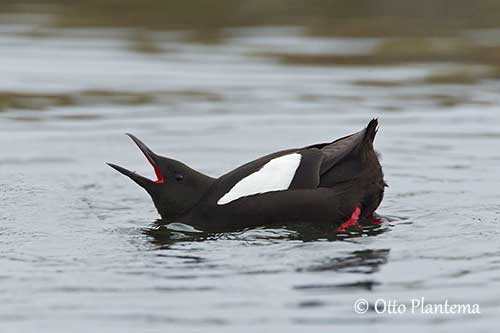
BEHAVIOUR IN THE WILD:
The Black Guillemot feeds mainly on fish in the southern part of the range, and it takes more crustaceans farther north.
The fish diet includes species that live near the bottom in shallow water, such as Ammodytidae, Pholidae, Cottidae, Stichaeidae, Arctic Cod (Boreogadus saida) and many other species and invertebrates (molluscs, jellyfish, crustaceans, sponges, crabs and occasionally barnacles).
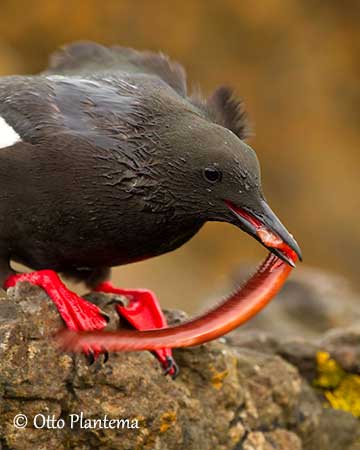
The Black Guillemot forages by swimming underwater and it propels itself with the wings. It may dive deeply as it feeds mainly on or near the bottom. It may remain underwater for 25-40 seconds, exceptionally more (75-146 seconds) at depth of less than 20 metres, usually between 1 and 8 metres.
During summer, it feeds mainly inshore and close to the breeding areas.
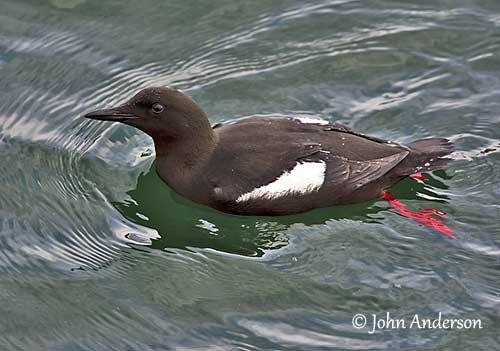
The Black Guillemot is territorial and defends its nest-site, the perching sites on stones, and especially the perches above the nest-site. During aggressive behaviour, it gives high-pitched whistles and attacks other birds with open bill in order to display the bright red gape. It also adopts a hunched posture with partially opened wings, and performs surface, aerial and underwater chases.
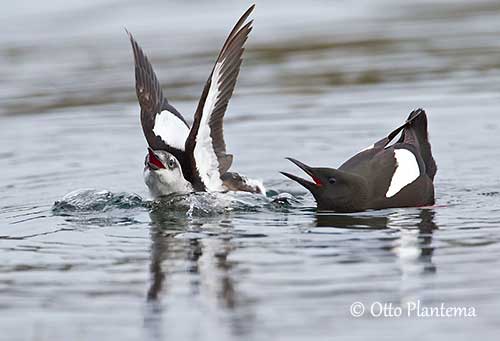
The Black Guillemot also performs elaborate courtship displays involving head bowing, whistling, and both mates turning and swimming in circles. The male also steps up and down with alternating feet while on female’s back during the copulation.
They are monogamous and return to the same colonies year after year, even using the same nest-site. They can breed as solitary pairs or in colonies of 10-100 pairs, much larger in the high Arctic.
Their nesting habitat sometimes overlaps with Razorbill and Atlantic Puffin.
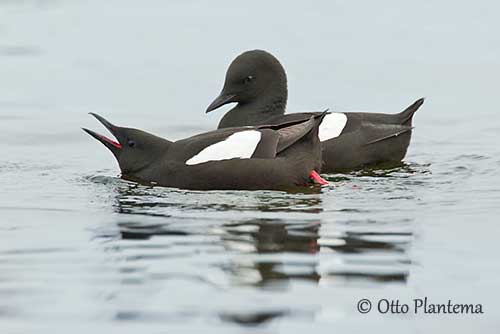
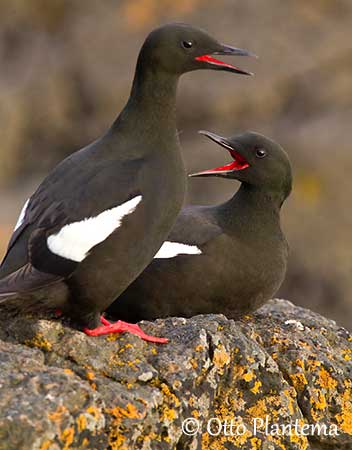
The Black Guillemot is resident and mostly sedentary, but in the northernmost regions, some movements to adjacent ice-free waters are reported. They moult in sheltered waters near the colonies, and spend the winter in these areas. However, the juveniles may move over long distances, often in direction of prevailing sea currents, but these dispersions are not very well understood.
The Black Guillemot walks more easily on land than other Alcids. In flight, the striking wing pattern is conspicuous on both sides of the whirring wings. In spite of their short wings used to swim underwater, this species retains a wing size which allows it to fly in both air and water.
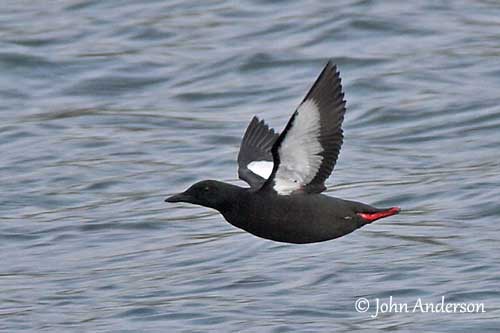
REPRODUCTION OF THIS SPECIES:
The laying may vary depending on the range. It usually occurs between late May and mid-June, but sometimes earlier in N Norway or later in Spitsbergen, Franz Josef Land and Novaya Zemlya, according to water conditions. It breeds in small scattered colonies or singly, although some colonies may include more than 1000 pairs in N of range.
The nest is placed in rock crevice at cliff base, or in cavity in cliff face, or under driftwood or debris, usually close to the water. This species requires at least 80 snow-free days for the complete breeding cycle.
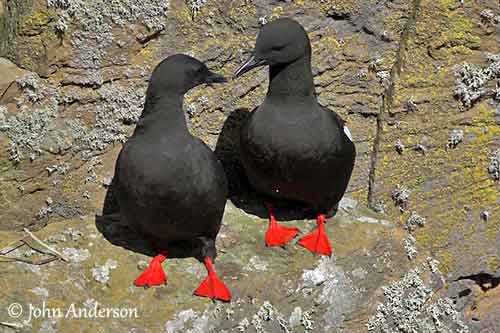
The female lays 1-2 whitish eggs with dark markings, and both adults share the incubation during 28-32 days, each adult during several hours. At hatching, the downy chicks are blackish-brown with red mouth-lining and black legs and feet. They are semi-precocial and wander inside the nest crevice.
They are fed by both parents with up to 20 fish per day. The adults bring only one fish at a time by carrying it crosswise in the bill. They are fed until they fledge, between 30 and 40 days after hatching. Once fledged, the chicks become independent. They start to breed at 3-4 years of age.
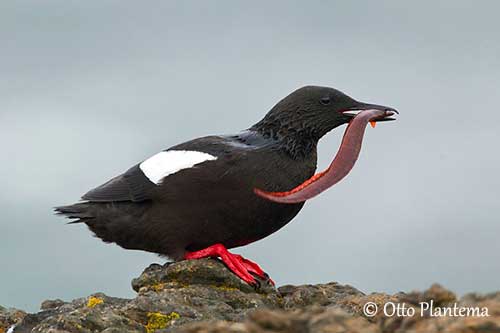
PROTECTION / THREATS / STATUS:
The Black Guillemot is a pagophilic species (ice-dependent), and the survival of this species is tied to the arctic pack ice. The decrease in the extent of ice cover since the late 1970s is a threat for this auk. In addition, the Black Guillemot is vulnerable to oil spills close to the shores where it spends the winter, and it is affected locally by the impact of introduced minks and rats.
The global population is estimated to number 400,000/700,000 individuals (1996) and the trend is increasing in NE North America and British Islands. Declines are recorded in W Norway and E Canada since several decades.
But currently, the Black Guillemot is evaluated as Least Concern.
